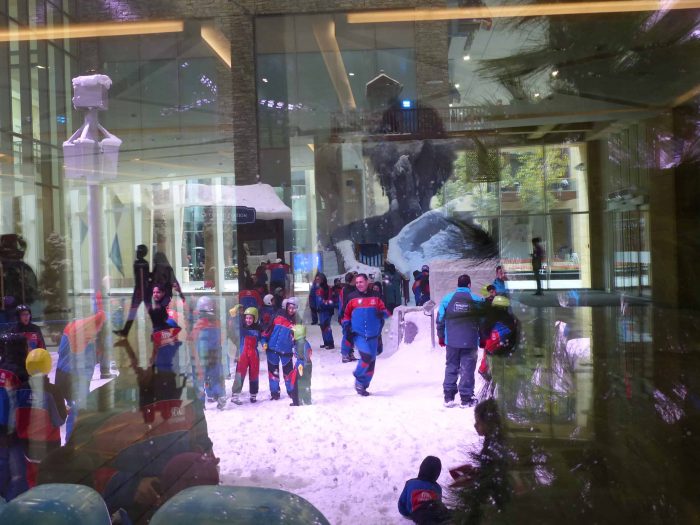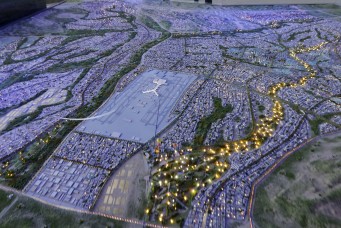Consuming Snow in Desert Shopping Malls
Mega-mall development in Cairo’s suburbs follows a neoliberal model of consumerism popular across the Middle East.

People playing snow games, Ski Egypt Amusement Park in Mall of Egypt, Sheikh Zayed, Cairo, Egypt, March 23, 2018. Mona Abaza
Situated in the grandiose, newly opened Mall of Egypt, Ski Egypt offers skiing sessions and lessons to adults and children at prices ranging from 200 Egyptian Pounds to 855 Egyptian Pounds (roughly $12 to $47). These are not cheap entrances for the vast majority of Egyptians. Ski Egypt, like the Magic Planet and Vox Cinemas companies, are all exact replicas of attractions in Dubai’s famed mega-malls. The fascination of skiing—of white and bright snow surrounded by endless sand and unfinished construction landscapes—is certainly catching. The mirage-like Mall of Egypt is a surreal construction, lost in the vast space of the desert in Cairo’s satellite city, the Sixth of October.
When you visit, you keep asking yourself: Why are so many wealthy Arabs mesmerized by the simulacra of mini-Switzerlands, of artificial snow landscapes in the confined spaces of closed-up, glassed-in malls all over the Middle East? Does the sensation of skiing on artificial snow in compulsory gloves provide a sensual, self-elevating feeling of “conspicuous leisure” and “conspicuous consumption,” so strikingly prophesied by the late sociologist Thorstein Veblen as the grand malaise of modernity?
Anything that is rare is highly desired, and in Egypt nothing is more available than sand. Snow is just the opposite. Why has the insatiable desire to mimic Dubai, the “Arab Riviera,” the dream world of abundance, luxury, milk and honey, become so imperative since 2011? The neoliberal powers seem to regard this kind of development as an urgently needed facelift after the troubled years of the Arab revolutions, the devastating civil wars, the unprecedented massive migration of refugees to Europe, the acute humanitarian disaster of the greatest population displacements in modern history, and the emergence of the threat of ISIS on a global scale.
When you enter a Cairene mall, forget all about the Weight of World (the famed work by the late French sociologist Pierre Bourdieu on contradictory behaviour regarding class disparities). Just keep on strolling through the endless kilometers of shops, cafes, restaurants, and what not, and keep on staring, for life there looks different from the one you know. And if you visit the Mall of Egypt, don’t lose yourself watching people wearing rented winter jackets and gloves for playing in the snow, and don’t be mesmerized by the mass of digital photographs of the people skiing and playing in the snowy hall, displayed on computers nearby. Take the escalator one floor up; observe the poorer visitors with their children who can’t afford the entrance tickets. Do the poor get satisfaction by staring for hours at the other people through the huge window? Window shopping still costs nothing, and so far no entrance ticket to the mall itself is required.
I have observed in my previous work that as far back as the early 2000s, Cairo boasted several gargantuan shopping malls, such as City Stars, located near the airport, to attract tourism from the Gulf. In spite of the growing poverty that could not be halted by the neoliberal policies of the Mubarak regime, consumer culture was booming, benefiting some people, but certainly not all. This was reflected in the spread of mobile phones, the fast food industry, home delivery, a flourishing local fashion industry, the multiplication of Carrefour and other hypermarkets. With the speed of the internet, Facebook and other social media became consumer goods. Also since the early 2000s, the Emirati Majid al-Futtaim group extended their financial empire by building numerous gigantic malls not only in Egypt but across the Middle East. In response, nearly a decade ago, I wrote that the Middle East was suffering from the construction of a racial segregation wall around Israel, and that the horrific war in Iraq was happening simultaneously with the opening of more new mega-malls in Dubai and in a number of cities in the Gulf. Also more than a decade ago, a snow city and an ice rink in a shopping mall in Cairo’s Nasr City were simultaneously erected and celebrated. And yet, the shopping Mall was quickly shut down because snow cities and ice rinks were not sustainable financially.
So what´s really new about these current mega-malls? In effect what´s really new about Cairo’s imitation of Dubai?
The number of malls has more than quadrupled during the past decade in Cairo’s suburbs of New Cairo, Sixth of October, and Sheikh Zayed. These malls replicate in standardized, monotonous shapes. It is this sameness that creates a semblance of democracy, so that we can all feel elevated to dream of being elsewhere, as long as we are in the confines of the mall, while in reality we remain in Cairo. This mesmerizing replicability has been led by the Majid al-Futtaim group in the Middle Eastern cities of Beirut, Sharjah, Bahrain, Alexandria, and Muscat.
Middle Eastern countries have now entered a race over which Arab country has the biggest mall in the world. This also means that the next generation of malls will be even larger. Today, the Al-Futtaim group runs 21 huge shopping malls. They advertise their success story on their website by claiming that these spaces welcome 178 million visitors annually. They also boast that they employ over 40,000 people, and enjoy “the highest credit rating (BBB) among privately-held corporates in the region.” This pride in extreme dimensions verges on megalomania.
However, a major question seems to be formulating itself: How should one experience, or rather read, these replicable, multipliable spaces of leisure after millions took to the street demanding bread, freedom, and social justice? The juxtaposition of these hyperspaces to Cairo’s sprawling slums will certainly not remove the latter, nor will it eliminate the robust Cairene street life of the old central neighborhoods. And what about the impact of the Malls, on the majority of Egyptians, of the soaring economic crisis after the severe devaluation of the pound? How about the frightening decline of the economic power of the middle classes? If our forefathers, in theorizing on consumer culture, prophesied that modern man remains utterly discontented and unsatisfied, it is because precisely his desires have been over-aroused and mistaken for needs. And even if the act of mimesis is close to perfection, Cairo is still not quite Dubai and fortunately never will be.
The decisive question will be how these opposing lifestyles—the wealthy skiers, of the multiple replicas of “New Cairos” of the desert satellite cities, versus the window watching “common folk” or sha’abi—will incite further dreams and desires for the have-nots. Clearly, the voyeur, the window shopper, the sha’abi common folk, will have to live with merely gazing at the wealthy skiers… but no one can be fooled with window shopping forever.
Mona Abaza is an Egyptian writer and professor of sociology at the American University in Cairo. Her most recent book is The Cotton Plantation Remembered: An Egyptian Family Story. Cairo: American University in Cairo Press, 2013.



